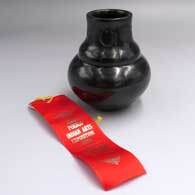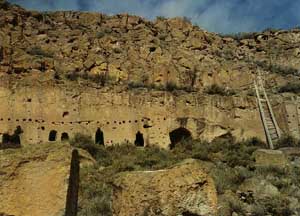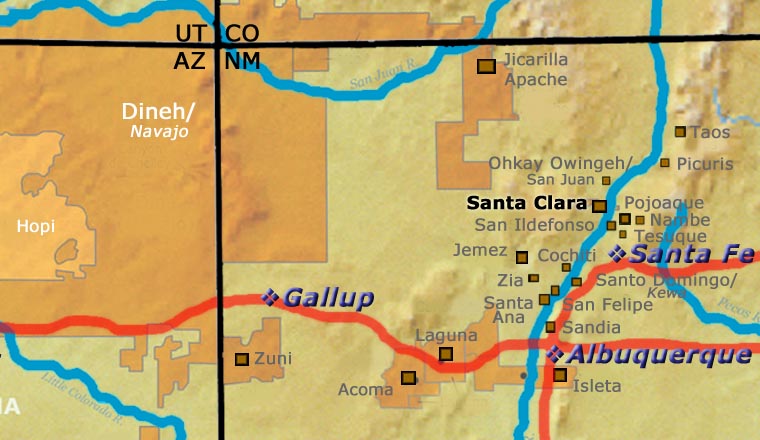
Shirley Tafoya
1947-2010
Santa Clara

Shirley Cactus Blossom Tafoya was born into Santa Clara Pueblo in 1947. She was the daughter of Margaret Tafoya and Alcario Tafoya, granddaughter of Sarafina Tafoya and Geronimo Tafoya.
Shirley was a bit of a wild child but she was an excellent potter. When Walt Youngblood decided he wasn't going to support his daughter Nancy any more, Shirley took her in. Nancy referred to her as "Aunt Berda" and the two of them sometimes prowled around the Santa Fe Plaza selling miniature black pots they'd made for $20-$25 each. Shirley became known for her carved blackware bowls and jars and for her polished blackware wedding vases.
Shirley's work was featured in the 1974 Seven Families in Pueblo Pottery exhibit at the Maxwell Museum of Anthropology at the University of New Mexico in Albuquerque. She was also a participant in the One Space/Three Visions major tri-cultural exhibit at the Albuquerque Museum in 1979.
Toward the end of her mother's life, Shirley and Margaret were almost inseparable. When Andrea had the show for Margaret's 94th birthday at Andrea Fisher Fine Pottery, Shirley told Andrea that Margaret had been so nervous her clothes were laid out on the bed a week in advance.
Some Awards Shirley Won
- 1998 Santa Fe Indian Market, First Place for a miniature vase, First Place for a miscellaneous miniature and Third Place for a jar less than 7 inches tall
- 1992 Santa Fe Indian Market, Miniature Pottery Award, First Place for a miniature vase, Second Place for a miscellaneous miniature and Second Place for a carved bowl
- 1991 Santa Fe Indian Market, Second Place for an undecorated wedding vase
- 1990 Santa Fe Indian Market, First Place award for a miscellaneous piece
- 1989 Santa Fe Indian Market, First Place for a miscellaneous miniature, Second Place for a miniature jar and Second Place for a miniature vase
- 1988 Santa Fe Indian Market, First Place for a vase (including wedding vase) and Second Place for a jar
- 1986 Santa Fe Indian Market, Second Place for a non-traditional form
- 1984 Santa Fe Indian Market, First Place for a bowl, Second Place for a miscellaneous miniature
- 1981 Santa Fe Indian Market, Second Place award
- 1980 Santa Fe Indian Market, First Place award
- 1979 Santa Fe Indian market, Third Place award for a miniature brown jar
- 1978 Santa Fe Indian Market, First Place award for a miniature pot
- 1977 Santa Fe Indian Market, First Place award for a water jar, Second Place award for a carved black jar
- 1976 Santa Fe Indian Market, First Place award for a black melon bowl
- 1975 Santa Fe Indian Market, First Place award for an undecorated bowl
- 1974 Santa Fe Indian Market, First Place award
100 West San Francisco Street, Santa Fe, New Mexico 87501
(505) 986-1234 - www.andreafisherpottery.com - All Rights Reserved

Santa Clara Pueblo

Ruins at Puye Cliffs, Santa Clara Pueblo
Santa Clara Pueblo straddles the Rio Grande about 25 miles north of Santa Fe. Of all the pueblos, Santa Clara has the largest number of potters.
The ancestral roots of the Santa Clara people have been traced to ancient pueblos in the Mesa Verde region in southwestern Colorado. When that area began to get dry between about 1100 and 1300 CE, some of the people migrated eastward, then south into the Chama River Valley where they constructed several pueblos over the years. One was Poshuouinge, built about 3 miles south of what is now Abiquiu on the edge of the Jemez foothills above the Chama River. Eventually reaching two and three stories high, and with up to 700 rooms on the ground floor, Poshuouinge was occupied from about 1375 CE to about 1475. Drought then again forced the people to move, some of them going to the area of Puye (on the eastern slopes of the Pajarito Plateau of the Jemez Mountains) and others downstream to Ohkay Owingeh (San Juan Pueblo, along the Rio Grande). Beginning around 1580 CE, drought forced the residents of the Puye area to relocate closer to the Rio Grande and they founded what we now know as Santa Clara Pueblo on the west bank of the river, with San Juan Pueblo to the north and San Ildefonso Pueblo to the south.
In 1598 the seat of Spanish government was established at Yunque, near San Juan Pueblo. The Spanish proceeded to antagonize the Puebloans so badly that that government was moved to Santa Fe in 1610, for their own safety.
Spanish colonists brought the first missionaries to Santa Clara in 1598. Among the many things they forced on the people, those missionaries forced the construction of the first mission church around 1622. However, like the other pueblos, the Santa Clarans chafed under the weight of Spanish rule. As a result, they were in the forefront of the Pueblo Revolt of 1680. One Santa Clara resident, a mixed black and Tewa man named Domingo Naranjo, was one of the rebellion's ringleaders. However, the pueblo unity that allowed them to chase the Spanish out fell apart shortly after their success, especially after Popé died.
When Don Diego de Vargas came back to the area in 1694, he found most of the Santa Clarans on top of nearby Black Mesa (with the people of San Ildefonso). A six-month siege didn't subdue them so finally, the two sides negotiated a treaty and the people returned to their pueblos. However, successive invasions and occupations by northern Europeans took their toll on all the tribes over the next 250 years. Then the swine flu pandemic in 1918 almost wiped them out.
Today, Santa Clara Pueblo is home to as many as 2,600 people and they comprise probably the largest per capita number of artists of any North American tribe (estimates of the number of potters run as high as 1-in-4 residents).
Today's pottery from Santa Clara is typically either black or red. It is usually highly polished and designs might be deeply carved or etched ("sgraffito") into the pot's surface. The water serpent, (avanyu), is a very common traditional design motif on Santa Clara pottery. Another motif comes from the legend that a bear helped the people find water during a drought. The bear paw has appeared on much of their pottery ever since.
Santa Clara has received a lot of distinction because of the evolving artistry the potters have brought to their craft. Not only did this pueblo produce excellent black and redware, several notable innovations helped move pottery from the realm of utilitarian vessels into the domain of art. Different styles of polychrome redware emerged in the 1920s-1930s. In the early 1960s experiments with stone inlay, incising and double firing began. Modern potters have also extended the tradition with unusual shapes, slips and designs, illustrating what one Santa Clara potter said: "At Santa Clara, being non-traditional is the tradition." (This refers strictly to artistic expression; the method of creating pottery remains traditional).
Santa Clara Pueblo is home to a number of famous pottery families: Tafoya, Baca, Gutierrez, Naranjo, Suazo, Chavarria, Garcia, Vigil, and Tapia - to name a few.
100 West San Francisco Street, Santa Fe, New Mexico 87501
(505) 986-1234 - www.andreafisherpottery.com - All Rights Reserved


